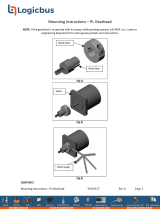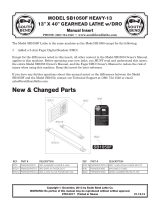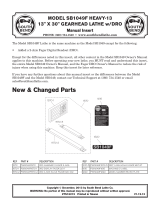
−2−
Table of contents
1 Introduction ......................................................... 3
1.1 Before using the product ...................................... 3
1.2 Related operating manuals..................................3
2 Safety precautions ............................................. 4
3 Preparation ........................................................... 6
3.1 Checking the product ............................................ 6
3.2 How to identify the product model .................. 6
3.3 Information about nameplate ............................ 6
3.4 Products possible to combine ............................ 7
3.5 Names and functions of parts .............................9
4 Installation ..........................................................10
4.1 Installation location ..............................................10
4.2 Installing the speed controller ..........................10
4.3 Installing the capacitor ........................................11
5 Connection .........................................................12
5.1 Connecting the AC power supply and
capacitor ...................................................................13
5.2 Connecting the motor and speed
controller ..................................................................14
5.3 Grounding ................................................................14
5.4 Connecting the control DC power supply
and I/O signals ........................................................15
5.5 Connection example for I/O signals and
programmable controller ...................................17
6 Operation ............................................................18
6.1 Power ON..................................................................18
Test operation ............................................................19
6.2 Starting, stopping .................................................19
6.3 Setting the rotation speed .................................20
Setting method using the operation panel ....20
Remote setting method ......................................... 21
6.4 Setting the acceleration time and
deceleration time ..................................................21
6.5 Motor rotation direction .....................................22
6.6 Timing chart ............................................................22
6.7 Operating cycle ......................................................23
Limitation in vertical drive ..................................... 23
6.8 Brake current ...........................................................23
6.9 Operating in vertical direction .........................24
Notes about vertical drive ..................................... 24
Conditions for vertical drive ..................................24
6.10 Operating at two or more speeds
(multi-speed operation) ......................................25
6.11 Adjusting the rotation speed of two or
more motors by a single setting device
(multi-motor control) ...........................................26
7 Function ............................................................... 27
7.1 Functions list ...........................................................27
7.2 Operation panel transitions ...............................28
7.3 Items that can be monitored ............................30
7.4 Setting the operation data .................................30
7.5 Setting the parameters .......................................31
Parameter list .............................................................. 31
Display of the rotation speed ...............................32
How to calculate the speed reduction ratio
when displaying the conveyor transfer
speed ............................................................................. 32
Limits the setting range of the rotation
speed ............................................................................. 32
Stop mode selection ................................................ 33
Setting the deceleration control ......................... 33
Description of I/O signals that can be
assigned .......................................................................34
7.6 Releasing operation of electromagnetic
brake ..........................................................................34
7.7 Prohibiting data editing ......................................34
8 Alarms ...................................................................35
8.1 Alarms ........................................................................35
8.2 Warnings ...................................................................37
9 Troubleshooting ...............................................38
10 Maintenance and inspection .......................39
10.1 Inspection ................................................................39
10.2 Warranty ...................................................................39
10.3 Disposal .....................................................................39
11 Cable and peripheral equipment
(sold separately) ................................................ 40
12 Regulations and standards ...........................41
12.1 UL Standards, CSA Standards ............................41
12.2 CE Marking ...............................................................41
12.3 RoHS Directive ........................................................41
12.4 Republic of Korea, Radio Waves Act ...............41
12.5 Conformity to the EMC ........................................42
13 Specications ..................................................... 44
13.1 Specications ..........................................................44
13.2 General specications ..........................................44
























